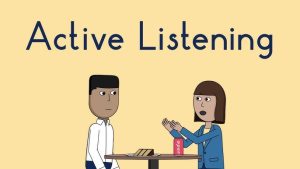
Conversation tips. The ability to strike up a conversation is a great networking and relationship-building skill, whether you’re adjusting to a new career or are about to meet a new professional contact. But when you first meet someone, it might be difficult to find the appropriate words. There are a few good methods to start a discussion, regardless of the circumstance or the other person’s disposition.
CONVERSATION TIPS
Asking open-ended questions and demonstrating genuine interest are two ways to engage in active listening and enhance interactions. To keep the conversation going, identify common ground, avoid interruptions, and maintain good body language. Giving praises, offering or asking for assistance, and having a few planned topics can all be excellent methods to start and carry on a conversation.
1. Active listening;

When listening actively, the emphasis is on paying close attention to what the other person is saying. Occasionally, people listen to reply instead of hearing what their conversation partner has to say.
2. Asking and answering questions;
Asking follow up questions abut other person’s remarks can lead to a longer conversation. Alternatively, you can ask them about anything you’re curious to learn more about or that you didn’t dully comprehend
3. Finding mutual interests and similarities;

Listen for experiences that you both share in common during the chat. Having similar interests might help you stay on topic and maintain a smooth flow of discussion.
4. Having an intention for the conversation;
It’s usually a good idea to prepare a plan for the conversation, whether you’re at a networking event or you ran into a coworker in the shop.
It’s usually a good idea to prepare a plan for the conversation, whether you’re at a networking event or you ran into a coworker in the shop.
1. Ask lots of questions;

Posing questions demonstrates your curiosity and attentiveness. Just remember to let the other person speak and take the initiative. You don’t want kids to experience questioning.
2. Avoid controversial topics;
Always pay attention to the context and the person you are speaking with. Steer clear of subjects that can be interpreted as offensive or contentious. This could be anything from the most recent PTA meeting’s agenda to politics or religion.
3. Make eye contact;

CONVERSATION TIPS
Maintaining eye contact with them demonstrates your interest in and participation in the discussion.
You convey to the other person that you are either preoccupied or uninterested in what they are saying if you are constantly gazing around
4. Smile;
It’s very crucial to smile while striking up a discussion.
Before you both speak, give your potential discussion partner a smile. This will demonstrate your friendliness and approachability.
5. Give compliments;

CONVERSATION TIPS
A complement is a kind gesture that is always appreciated. Your conversation partner will feel better about themselves if you compliment them. Plus, it will make your conversation richer.
6. Ask for advice or recommendations;
Seek guidance or suggestions if you’re unsure of how to maintain a discussion. This demonstrates your active listening skills and your appreciation for their opinions.
7. Prepare some topics beforehand;

CONVERSATION TIPS
Prepare some talking ideas ahead of time if you want to know how to lead a conversation with the greatest amount of success.
You can prepare speech topics for certain circumstances, including meetings with bosses, colleagues, or lifelong friends. If you prepare ahead of time, you won’t find yourself at a loss for words. Click here for more updates.
Summary
Talking to a new friend or acquaintance will be different from talking to your coworkers or business associates. Your early attempts can spark a discussion that could later benefit you by enabling you to establish beneficial connections with colleagues and coworkers.